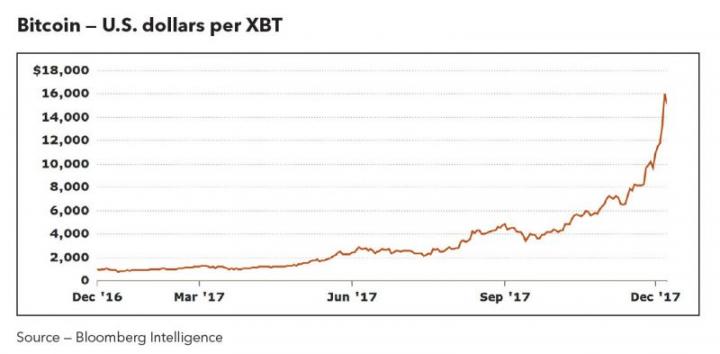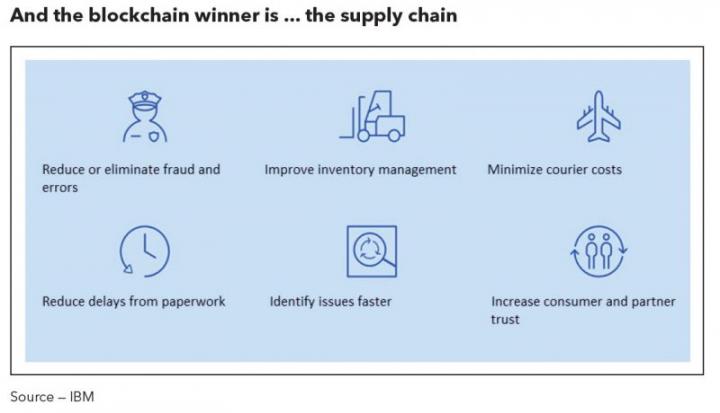Blockchain Is Coming Everywhere, Ready or Not
The applications of blockchain technology will spread in 2018 far beyond bitcoin and, perhaps more surprisingly, way beyond financial services. Significant disruption and new business opportunities are on the menu. Four of the most-critical benefits from distributed-ledger technology can be encapsulated within trust, transparency, cost and speed. Where will the disruption occur?
Blockchain is now a familiar term to many, though in most cases, its meaning will be inextricably linked to bitcoin after a 10-fold price surge in 2017 valued the cryptocurrency at more than $180 billion.
This is only one strand of the story for Europe and globally. The applications of blockchain technology will spread in 2018 far beyond bitcoin and, perhaps more surprisingly, way beyond financial services.
For starters, huge improvements in efficiency and transaction speeds, cost savings and enhanced security are on the menu, with significant disruption and new business opportunities likely to follow.
JPMorgan Chase was among dozens of banks discussing plans and capacity for blockchain through 2017. CEO Jamie Dimon famously lauded the technology as “good,” while labeling bitcoin as “dangerous” and suggesting he would fire any trader who dabbled with it.
Software companies in Europe including SAP and Sage have also joined the party and are vocal about blockchain’s future. Perhaps less obviously, management from companies as varied as Italian utility Enel, German giant Siemens, telco-network provider Swisscom and oil major BP also devoted time on analyst calls in late 2017 to discuss the topic and its potential impact on their industries.
Distributed-ledger technology
Putting the semantics to bed early, blockchain is the name designated to a string or chain of transaction records (blocks), cryptographically signed with “hashes,” or digital signatures. Though undoubtedly the most high-profile application of blockchain, the bitcoin network is just one example of how cryptocurrencies and other transactions can use this technology.
Blockchain is effectively the means to create tamper-proof records of data and transactions — whether that is a money transfer, vote cast, medical record or change of property ownership. It is just one of a variety of decentralized database technologies that exist across multiple locations. These are known as distributed ledgers, and it is within these so-called DLT technologies that great opportunity exists.
Double-entry accounting 2.0
Double-entry accounting, popularized by Italian monk and reputed magician Luca Pacioli in 1494, revolutionized accounting, valuation and capitalism. Comparisons are increasingly drawn with DLT and its capacity to revolutionize security, verification and recordkeeping across legal, economic and governmental systems — and they may not be as far-fetched as they sound at first.
At its heart, DLT is a public ledger that — unlike a regular database — isn’t stored on a centralized server but rather one duplicated and verified across multiple computers (nodes) running the software. This eradicates the need for and risks from middlemen or trusted third parties.
Four of the most-critical benefits from distributed-ledger technology can be encapsulated within trust, transparency, cost and speed.
Trust gets built as the risk of hacking and fraud is greatly reduced, with the possibility of data tampering reduced to virtually zero, notably so as the network grows larger. Control of information is shared by the users with a complete and consistent record. Once a transaction is agreed to and shared across a network, it is nearly impossible to undo. The lack of middlemen or “centralized monopolies” removes costs and will ultimately lower barriers to entry, further improving efficiencies. Add to this a vastly increased speed for transactions and verification, and the attractions are clear.
The $16 billion reason to play
Banking and payments are the obvious place to start for blockchain opportunities and are probably the main focus currently.
The requirement to “know your customer” is tailor-made for blockchain solutions, and the incentive to avoid fines for sanctions or anti-money laundering breaches is huge, after BNP was forced to pay $8.9 billion, topping the list of 13 banks doling out more than $100 million each ($16.1 billion in total) for U.S. sanctions breaches from 2008 to 2015.
Royal Bank of Scotland has demonstrated other potential streamlining benefits beyond complying with onerous anti-money-laundering rules. With a staff of 2,000 focused exclusively on know-your-customer compliance at the start of 2017, the bank, with the help of digital solutions, aims to lower this headcount by 95%. The cost and time efficiencies that blockchain-enabled recordkeeping and identity verification would bring are clear, to say nothing of improved customer satisfaction.
Supply chain a big winner?
Supply-chain management is effectively a list of transactions that track products from point of sale through to final deployment and is a huge part of global trade. Fraught with inefficiencies, from human error, inventory mismanagement, financing and shipping, the number of links in the chain remains a key challenge.
Blockchain will enable a real-time, validated ledger providing visibility of the location, condition and owner of an asset, which should cut fraud costs and streamline order management. Car leasing in Europe is a 350 billion-euro market and another prime example of an industry ripe for digital change. Its variety of stakeholders — finance, insurance, manufacturer, dealerships, registration — provide significant opportunity for streamlining to reduce complexity, cost and fraud.
Health care is another vast industry where numerous stakeholders are hamstrung by the inability to share data securely. There are opportunities for improved collaboration between providers leading to more accurate diagnoses, effective treatments or a streamlined interface between insurers and health-care providers — or more simply, doctors having instant access to medical records and histories via digital signatures.
In similar fashion, real estate traditionally suffers from a lack of transparency during and after transactions, with mountains of paperwork (deeds, titles), significant fraud risk and errors a common and costly problem. Distributed-ledger technology provides the ability to speed transactions and dramatically improve recordkeeping and solutions, so expect the industry to be talking blockchain technology in 2018.
Energy management and supply, government and public records, voting, the legal profession (wills, inheritance) and all forms of insurance will be talking the blockchain talk in 2018 and beyond. In any sphere of public or business life where a trusted status, a variety of stakeholders, payments and identity verification are all present, blockchain or distributed-ledgers technologies — take your pick — will be there. The first wave will be about costs, enhanced security and speed. After the streamlining will come the disruption.
It’s not just companies. Countries also will be dealing with blockchain. A 2017 IBM survey suggests that nine out of 10 governmental organizations (among 200 across 16 countries) plan to invest in blockchain in 2018. Citizen services (voting, land registration, tax collection), regulatory compliance, identity management and contract management (such as waste collection) were the areas most commonly identified.
Sweden is considering launching a purely digital form of currency, with central banks from Singapore and Canada also studying their options. The UN wants scalable identity systems by 2020, and Dubai wants to go paperless by 2020.
Whether you buy bitcoin as a concept, you will soon be buying insurance, cars and visas for your holiday using blockchain-like technology. Watch this space.
This article is by Bloomberg Intelligence analyst Jonathan Tyce and the European research team. It appeared first in Bloomberg Intelligence’s report, The Year Ahead 2018.

Don’t miss out – Find out more today





